“Desk buddies” are succulents that look good on your desk and require almost no care. They’re cute and classy, and visitors invariably ask about them. All you have to do is dribble water on them twice a month (which also keeps them dusted).

Here for your enjoyment is a step-by-step DIY project for creating a sparkling trio of succulent desk buddies. Watch the corresponding YouTube video.
I chose haworthias for my desk buddies because they do great in terrariums. These small succulents from South Africa are rosette-shaped and shades of green, sometimes variegated with cream or white. Certain species have translucent tissue and veining on leaves. Most haworthias prefer bright shade, grow no more than 4 or 5 inches in height and diameter, and offset to form mounding colonies. Outdoors, they need protection from sun scorch and frost.
Recently I brought home several haworthias in 2.5-inch nursery pots to create a trio of desk buddies, inspired by Altman Plants’ collection with the same name. Another great online source is Mountain Crest Gardens.
Plants*

Haworthia fasciata hybrid. Similar to H. attenuata (zebra plant), the rosettes have stiff, upright, pointed leaves that appear sharp but aren’t.
Haworthia emelyae. Each leaf forms a fat triangle that curves up and outward. Leaf tops are translucent and veined. Similar to H. retusa.
Haworthia cymbiformis. Similar to H. retusa and H. emelyae, but offsets are more clumping.
Design
I wanted a simple, sophisticated trio that would showcase the plants, so I went with glass spheres. These have a clean, fresh look and don’t leave water spots on tabletops. (Lack of draingage is not a problem. If that seems counterintuitive, see How to Water Succulents.) I didn’t want any dirt to show, so I concealed roots beneath layers of sand in muted hues. You might add pebbles, beads or even buttons, but keep in mind that as sand sifts through and past them, bigger items work their way to the surface.
Materials

— 3 glass globe candle holders, each 4 inches in diameter
— Pumice (crushed white volcanic rock) about 2 T per container

— Several colors of sand. I chose light earth tones because subtle variations are best when seen up close. You might also consider colors that harmonize with furnishings or accessories. Cautions: Bright sand can call excessive attention to itself, overshadow the succulents, and suggest a Kindergarten project. Don’t use beach sand, which contains salts, or sand that’s green because it’ll suggest algae.
— Bowl or bucket of water for swishing soil off roots (optional).
— Soft artist’s brush for cleaning sand off leaves.
Method
— Slide plants out of their nursery pots, gently remove as much soil as possible, and swish the roots in water (optional). If some soil clings to them, that’s fine, just so it won’t be visible through the glass.
— Dip roots into pumice so it clings to them (optional). Add a couple of spoonfuls of pumice to the bottom of the globe and set the roots atop it. The plant might rest below the rim, suggesting a terrarium. If leaves are at mid-rim or slightly higher, the container will suggest a flower pot.
— Pour in different colors of sand to create layers. Experiment with tipping the globe to achieve curved or sloping lines. Avoid getting sand on leaves because you’ll have to clean it off.
— Tap the container gently to settle sand around roots.
— Think it could look better? Simply start over (remove contents, clean the glass). When you’re satisfied, gently brush grains of sand from the leaves.
— Use a squirt bottle to further cleanse the leaves and settle the roots. Avoid soaking the sand.
Care
— Dribble a little water on the plants every couple of weeks or so. Hold the globe so you can see where the water goes (wet sand will appear darker). You want it to go to the center, not the sides.
— Give haworthias as much bright light as possible but no direct sunlight. Sun may burn the leaves and cause algae to grow in damp sand.
— Over time, lower leaves may wither and dry, which is normal; snip and remove them with scissors and tweezers.
— If you don’t like the haworthias’ spindly blooms, you have my permission to pinch them off.
— Watch for pests such as aphids and mealybugs. Should they put in an appearance, spray with 70% Isopropyl alcohol.
— No fertilizer needed.
*Trying to accurately ID Haworthia species and cultivars is frustrating, to say the least. There are innumerable hybrids, and it takes an expert to tell them apart, especially when growing conditions may shorten or elongate leaves, or cause rosettes to have a flatter shape or greater or lesser variegation. Fortunately all have similar cultivation requirements, so if you see one you like, chances are it’ll do well for you, whatever the heck its name may be.
Related Info
On this site ~
On my YouTube channel ~
The post Succulent Desk Buddies appeared first on Succulents and Succulent Garden Design | Debra Lee Baldwin.
from Succulents and Succulent Garden Design | Debra Lee Baldwin https://ift.tt/2N1jDoj
via IFTTT


No hay comentarios:
Publicar un comentario